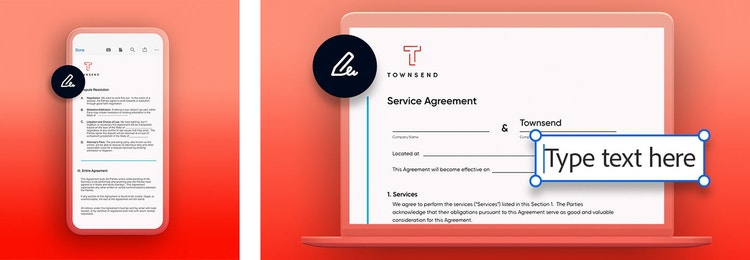Adobe Acrobat Sign
What is a contract for services or service agreement?
Businesses use a services contract for short-term or limited-scope agreements. Learn how to create a thorough contract, so you can work with independent contractors or freelancers.

What is a contract for services?
A contract for services is a written agreement between an employer and an individual to do work for a limited time period or of a limited scope. Also known as a service agreement, this type of contract is a binding, legal document that outlines the details of the job, compensation, and other terms of this agreement.

When do you need a contract for services?
Use a contract for services when you need to hire someone for a job without making that person a full-time employee. Consulting services, independent contractors, subcontractors, or freelancers may all require a services agreement.
Contract for services versus contract of service.
Though their names are practically identical, these two contracts serve entirely different purposes. A contract for services is used to hire someone for a temporary time period or limited amount of work, while a contract of service is an indefinite employment contract. An independent contractor agreement would be a contract for services, while a full-time at-will employee would require a contract of service.
Contract for services versus contract for goods.
A contract for services is also different from a contract for goods, which is used for the sale and delivery of physical items rather than services rendered. The two are governed by different laws, so make sure to pick the contract that fits the job at hand.

What to include in your contract.
Each contract for services will look slightly different, but you can use the following list to build your essential sections. Make sure to consult federal law, the governing laws of the state in which you operate, and any other applicable laws in your industry. And, as always, be sure to seek legal advice from an attorney, and have them review your entire contract before you send or sign it.
Description of services
Lay out exactly what professional services you and your company will receive. Be as detailed and specific as possible. Include itemized lists of types of services or quantifiable work products to help keep your wording concrete.
Payment terms
Describe when and how the contractor will be compensated. If reimbursement will take place on a payment schedule, make note of the calendar days the service provider can expect payment. Include a section on late payments, so there are no disputes over late fees or penalties.
Ownership rights
If any intellectual property, such as a logo, is to be created throughout the course of the contract, you will need to decide who retains the intellectual property rights of that content during the work and after the job is completed.
Confidentiality clause
A confidentiality clause protects from exposure any trade secrets or confidential information that your service provider may be privy to during the course of their work. This clause should also outline the consequences of a breach of confidentiality.
Indemnification clause
An indemnification clause is used as a kind of warranty or liability waiver against any harm or damages to property during the agreement. One party agrees to pay the fees, legal expenses, and other costs that may fall to the other party as a result of the work. It is similar to a hold harmless agreement, since one party agrees to hold the other harmless for any liability that may arise.
Amendment
An amendment section leaves room for the working arrangement to grow and evolve over the course of the agreement. If you think you might want to change something down the road, include a section that details how you and your service provider can make changes to the contract.
Termination
This section identifies how parties can end the relationship, if necessary, and who is responsible for the contract’s termination. If one party violates the terms of the contract, the other needs an exit plan, and this is the place to establish that safety net.
You may also want to add a severability clause to your contract, which states that if certain parts of the contract are found to be invalid or illegal, the remaining valid parts of the contract will stay intact.
Dispute resolution
Lastly, decide how you will handle disputes that may arise. Arbitration, mediation, or court intervention are the most common routes of dispute resolution. Generally, you’ll want to opt for the lowest possible level of intervention to keep costs down and resolve disputes faster.

Make and sign digital contracts with Adobe Acrobat Pro.
Make your own contract template with Acrobat Pro, and learn how e-docs can simplify your contract creation process while saving you time and money. With Acrobat, both parties can view, edit, and make comments on documents at the same time, which means a faster, more efficient drafting and negotiation process.
When it’s time to sign your contract, send it out for signature in one click. Track your progress, sign on any device, and get notified when the other party inks the deal.
